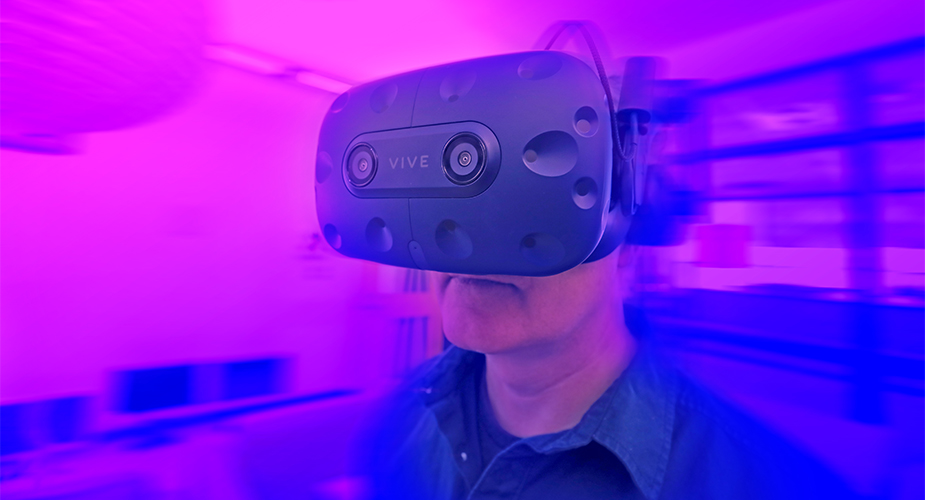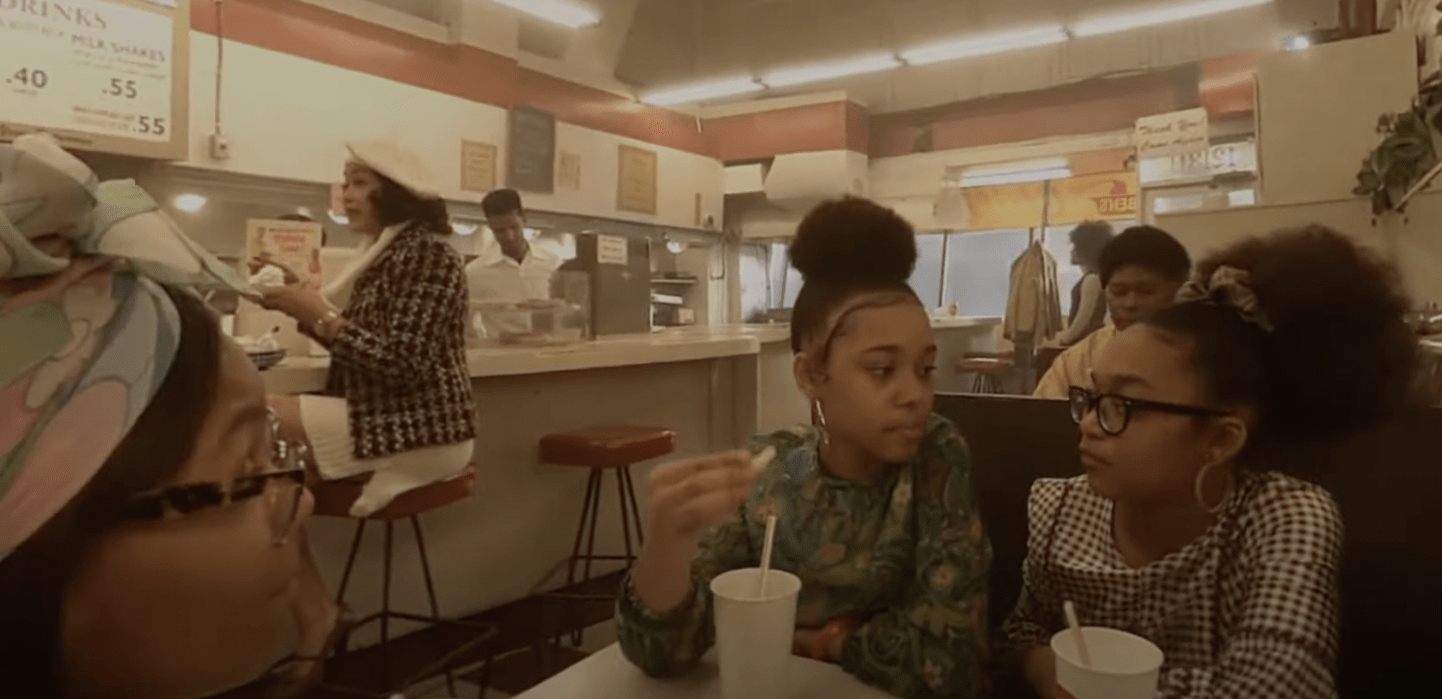Step into the metaverse

Photo: Bruce Murray
For better or worse, virtual technology will transform the way we work, play, and live together — meet the locals on the cutting edge
I remember the moment it clicked. Looking up the steep steps to Sacré-Coeur in Paris, I got reverse vertigo, regretting having skipped leg day. Only there was no climb ahead. I was on a level floor inside the (now closed) Reality Shop on Queen Street.
It was Google Earth, VR edition. Later, I’d be shooting trolls and flying like a superhero. But it was staring up at that architectural bastion of politics, art, and religion I felt “christened with wonder,” as John Mann once sang.
This was four years ago, long before I heard the term “metaverse” (which Neal Stephenson coined in his 1993 novel, Snow Crash). Also before Facebook rebranded itself Meta, “to encompass everything that we do,” as chief avatar Mark Zuckerberg said with robotic enthusiasm. This was in a company-released video, featuring mock-ups of Zuckerberg finger swiping outfits and playing poker with a robot. Fun! In a creepy, corporate-speak way.
The word “metaverse” makes me feel like Grandma, who owned a computer she rarely touched. I take solace from Wired Magazine luminaries, who also don’t know exactly what it is, or will become.
Take Eric Ravenscraft (good avatar name), who says the metaverse is “the future of the internet. Or it’s a video game. Or maybe it’s a deeply uncomfortable, worse version of Zoom?” Wicked.
Nora Young, host of CBC’s tech program, Spark, defines it as “an immersive virtual world.”
In that Neal Stephenson book I mentioned, it’s a place people go to escape the dystopian future.
All the definitions are abstract, fluffy, oversimplified.
The metaverse encompasses a series of different technologies. These include virtual reality (digitally generated worlds), augmented reality (a combination of physical and digital worlds, like the superimposed yellow first-down line in football broadcasts), cryptocurrency (digital money), and digital goods like avatar outfits and NFTs.
That last one? Stands for non-fungible tokens, chunks of tradeable data available via a blockchain, a sort of digital ledger. Go figure. (About 400,000 people own NFTs, compared to billions of online gamers. According to anonymous sources, most people think NFTs are stupid.)
As a Meta/Facebook promotional video depicts it, the metaverse is a shared, immersive audiovisual online space where users interact as avatars for business or pleasure. In most contemporary writing about the metaverse, there’s some element of commerce, the ability to make real cash or some digital representation of it, like cryptocurrency.
What’s crucial, what every observer (even Zuckerberg) notes, is the metaverse doesn’t really exist yet. The Meta/Facebook video is more far-out fictional than an artist’s representation of a proposed downtown development.
Current online gaming fascinations like Fortnite, Roblox, and Minecraft might be called prototype metaverse-like platforms for entertainment. And Meta/Facebook’s Horizon Workrooms (for which headsets alone cost $300) could be the business equivalent. But true sustainable immersive hangouts remain years from realization.
That’s largely a technological problem. While capitalists see a profit opportunity in this emerging tech, they’re playing a long game. Their marketers are playing on our fantasies. Industry watchers often reference that Facebook/Zuckerberg promotional video.
“Half of the things he does are not things I particularly want to do in virtual reality,” says Derek Reilly, who co-directs the Graphics and Experimental Media lab at Dalhousie University in Halifax. “You don’t want to wear one of the headsets needed for VR for more than 45 minutes.”
Reilly is an avid gamer, having spent more hours than he cares to count playing Minecraft. He shares excitement about immersive technologies. He is clear that “metaverse” is a marketing dream with many impediments.
“The time it takes to get into a collaborative work engagements is prohibitive,” he says. “Getting everyone into their headsets, logging in, configuring the avatars, learning the controls, navigating to the meeting location, making sure everyone can hear. You think Zoom is a pain? By the time it’s going, you’re too fatigued to work. Then there’s the virtual white board — no tactile feedback. It’s like signing your name with a mouse.”
In the Zuckerberg video, the virtual world crystalizes around a worker as he sits at his well-decked home-office desk. We’re a long way from even lightweight VR goggles, let alone being wireless in a virtual world. After a wave of technological innovation, it’s another 20 years before new technology becomes practical. It takes longer still before economies of scale make prices accessible.
VR’s progress has been fitful. Reilly says VR headsets have been around since the mid-1960s, and subsequent waves of innovation came in the ‘80s, ‘90s and around 2008.
“There are a lot of fundamental questions about interaction that have not been resolved,” he says. With burgeoning interest from large corporations like Meta/Facebook, Microsoft, Apple, and Epic Games, it’s reasonable to expect growth. “Something is going to emerge. I would suggest it’s going to be something slightly better than what we can find today.”
Reilly has had his share of compelling VR experiences, including chatting up strangers watching gorillas at a virtual zoo. “But they’re not ubiquitous or long lasting.”
He’s referring to the idea of slipping through worlds like a Zuckerberg avatar, from a card game to an urban-art hunt to a Peace Accord in Eastern Europe. The platforms are owned by different companies, so there’s no universal interface for the user; to each world a different set of equipment.
The amount of physical rendering required to create all those virtual worlds is mind-numbing. Heads, bodies, hands, and eye movements must be rendered and individualized. It takes rooms of expensive sensors, working independently then fused. All of which requires the kind of bandwidth rural Nova Scotians can only complain about not having.

PROFITUNITY
There’s gold in them virtual hills. The risk is large tech firms will grab it all.
Locally, the metaverse concept is having an impact. There are several VR-suite rental places in and around Halifax. A Polish online training firm called NobleProg offers “Metaverse Training in Nova Scotia,” via remote desktop at Purdy’s Wharf, for “developers who wish to become a future developer and contributor to Metaverse by building interactive simulations and experiences.”
“There has been and will continue to be a market for immersive VR and AR,” says Derek Reilly. “Modest Tree’s interactive training is a hot area.”
He’s referring to one of a handful of local companies providing immersive training experiences. Modest Tree was co-founded by CEO Emily Smits in Halifax in 2011. It creates deeper, more meaningful learning experiences for organizations. It’s locally based, with staff in Germany and the United States, and serves clients globally.
An example of their work is training maintenance and emergency-response repair workers on complex engines (automotive, marine or aircraft) in sometimes stressful conditions. “We would create a virtual environment based on a 3D model,” Smits says, “and provide a virtual walk-through of a work site for safety reasons, or look at a product and show different components and take it apart.”
The trainees can be anywhere in the world, joining by mobile phone, desktop, using VR headsets, and are led by an instructor. The geographic benefits are clear, plus it’s prudent to ensure a certain level of competence before exposing workers to dangerous conditions or high-cost equipment.
“There is also the ability to scale training applications,” Smits explains. “We can put a lot more learners in a digital environment.”
Smits says her company is unusual in that it provides its clients with software, so they can develop their own immersive-training programs. They aim to “democratize training.”
Another local tech firm, rooted in aviation training since 1978, is Bluedrop Training and Simulation, which specializes in aerospace and defence training programs, flight simulations to jumpstart learning pilots’ hearts — learning to avoid costly errors in judgment in the real world. All without risking lives or multimillion-dollar aircraft. Being in a military town helps. (Could we please have an app to help teens learn to drive?)
In entertainment, virtual and augmented reality lovers find the storytelling incredibly compelling.
“Immersion can yield a more compassionate response,” Reilly says, noting a Canadian-American documentary simulation called Traveling While Black, by director Roger Ross Williams, about the risks faced by Blacks travelling in 20th-century America. It’s set at Ben’s Chili Bowl, a safe place to stop and eat. It is far more engaging than watching a movie on flatscreen: being there, looking around the room, seeing the faces, talking to people about their experiences. Once you start, it’s an inescapable empathy builder.
RISK
A December 2021 report from counterhate.com warned “VR Chat — the most reviewed social app in Facebook’s VR Metaverse — is rife with abuse, harassment, racism, and pornographic content.” On today’s rudimentary virtual planes, “virtual groping,” male avatars assaulting female avatars, is a thing.
“There’ve been well-documented instances where your avatar is accosted by gangs,” Reilly says. “The assault can feel quite visceral.” And just as with every online application, there are perverts attempting to sexually exploit children.
Information privacy is also a concern. What else can social-media moguls learn about us that we haven’t already surrendered through our phones?
“Movement patterns, body size, how you respond to stimuli,” Reilly speculates. “What you’re looking at and when and for how long. Valence and arousal, stress reactions: more internal information.”
The metaverse is a more extensive, seductive internet, carrying many of the dangers of the real world, succumbing to the same temptations. Many of the same lessons apply. Don’t be tempted by the shiny apple; nothing’s free except bad advice. Our parents’ truisms.
What if the biggest danger of the metaverse is its creators? Weakly regulated multinational corporations determined to mine personal details we can’t even fathom?
Reilly counters with another question. “What does it mean to be a critical thinker in a hyper-technical environment?”
MORE PUNK ROCK
Governments should be forward thinking and willing to protect citizens, not only from individual creeps, but also from corporate data miners, and from the spread of disinformation in a more immersive version of the internet. Part of that may be working to make open-source creative tools accessible for community-minded virtual-world builders, the legions of anti-Zuckerbergs with the collective ingenuity to reclaim the internet. A scaled-up version of Emily Smits’s democratization of training.
As Reilly puts it, “We need to be a lot more punk rock. We can usurp or subvert the intentions or design of any structure designed top down. We can use it for free assembly or protest.”
Humanity doesn’t have a great track record of responsible tool management. But as social media has shown, things get dark before we find the light. It’s worth some forethought.
















